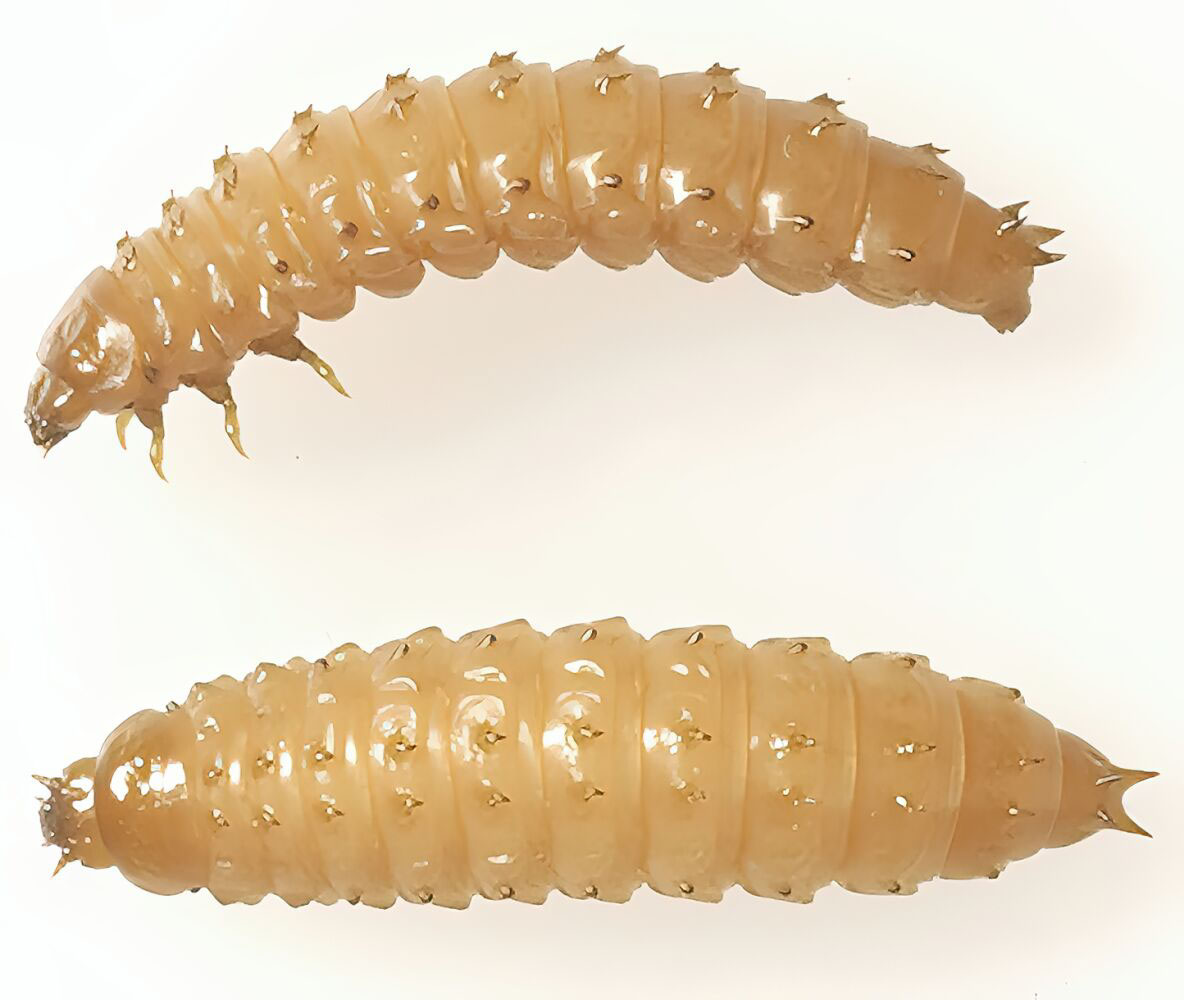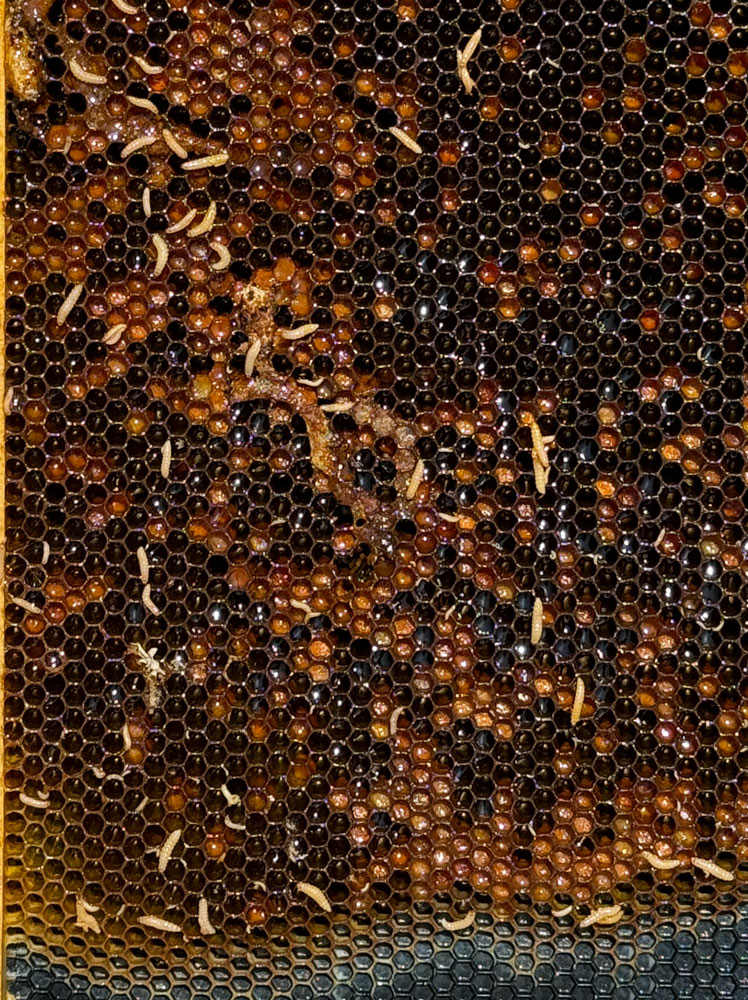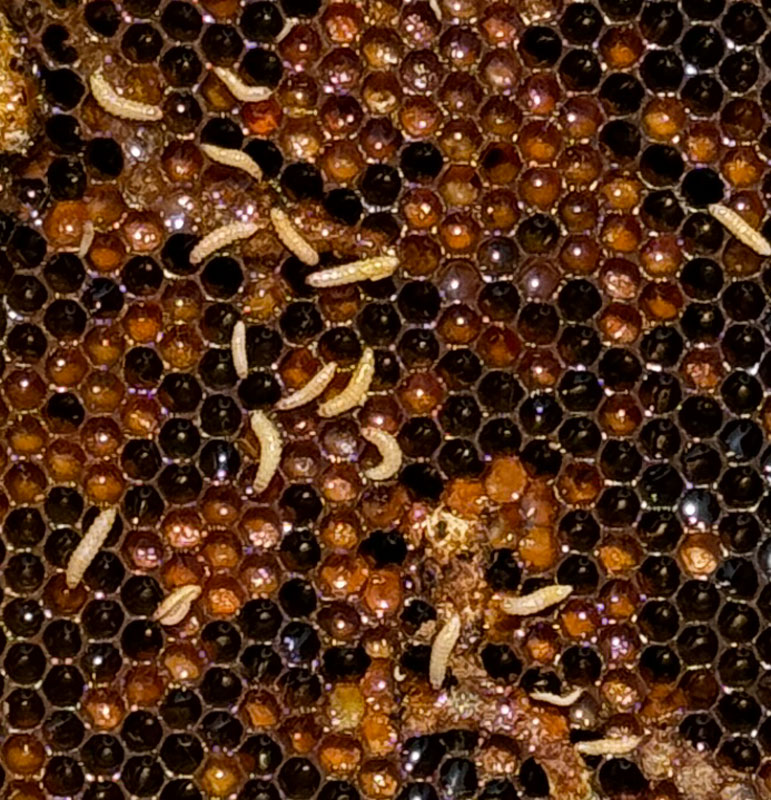
SoCal Beekeeping
P. Michael Henderson
June 5, 2024
Since I posted this I received a comment that the larvae of small hive beetles look very similar to the larvae of wax moths. I did some research and I agree. You can tell the difference but you need to examine the larvae closely, which I didn't do. I just assumed they were waxworms. It's possible the infestation I had was small hive beetles larvae. Next time I'll know to examine the larvae closely.
I haven't had any problems with small hive beetles in the past, but I have seen a few on the frames when we were doing the honey extraction, so I know they're there.
Here's a picture of a small hive beetle larvae:

And a waxworm:

The most apparent difference is the three sets of front legs in the small hive beetle larvae.
+++++++++++++++++++++++++++++++++++++++++++++++++++++
In July of last year, my friend, Janet, gave me a hive. It was somewhat of a mess, though. A swarm had moved into an empty hive in her yard and when we opened it, it was full of comb, but not on frames. It was pretty much like a cutout.
I was able to take some of the brood and put it into frames and then we took the hive to my place, and I put it in the beeyard. It was definitely in "recover mode" and I saw new brood in the hive.
With that, I left it alone to allow them to build up again.
However, around the end of April of this year, I noticed that there wasn't much activity in the hive. There just wasn't the number of bees flying in and out that I'd expect. So I went into the hive and discovered that it had gone queenless.
Not only that, but waxworms were in the old brood comb (more detail on waxworms here and here). Waxworms are the larvae of Wax Moths. The wax moths lay eggs on the old comb and the larvae that hatch from the eggs begin to burrow through the comb, eating the protein there. When bees go from the larvae stage to the pupae stage the pupae spins a cocoon. When the bee emerges, some of that cocoon remains in the cell and that's protein, which the waxworms eat.
The hive was a mess, but not as bad as others I've seen. I removed the frames that had waxworms and put the frames in the sun, which will kill the waxworms. Here's a picture of one frame infested with waxworms. This picture was taken June 1, 2024.

Zooming in a bit gives a better view of the larvae. You can see a worm track in the middle of the picture.

And finally, a real close-up.

If left in the hive, they will eventually develop into wax moths. In addition to wrecking the comb, they also create a spider web-like material so when you open the hive it's just a disaster.
Wax moths are always there, but a strong hive can deal with the moths and the larvae.
My problem, however, was to get more bees, and a queen, into the hive.
Luckily, I started getting calls to pick up swarms. Over a couple of weeks, I picked up four swarms and put them into the hive. The queens had to fight it out to decide who would remain.
What I noticed is that the bees started making new comb on a bare frame of foundation that I had in the hive. At the same time they started cleaning up the older comb and removing the waxworms. I found shredded comb and larvae (alive) in the bottom of the hive. I cleaned the bottom board a couple of times over a couple of weeks and there were no more waxworm larvae the last couple of times I cleaned it.
There's fresh brood in the hive now, just on that one frame, but I expect they will spread out to more frames soon. There are a lot of bees because of the four swarms that I put into the hive.
So, overall, I think I've put the hive back on track to develop into a productive hive.
The waxworms do serve a purpose in the ecology of bees. Suppose a hive swarms and the new queen goes on a mating flight but doesn't return. The hive is dead at that point - the population of worker bees will gradually decline until they're all gone.
The wax moths come into the hive and lay eggs that produce the waxworms. The worms eat all the protein containing areas of the comb, which essentially prepares the cavity for the next swarm that finds it and moves in.
++++++++++++++++++++++++++++++++++++++++++++++++++++++++
June 27,2024 I went into the hive today. A few weeks ago, I had checked the hive and the bees had made new comb on some bare foundation. That frame was on the outside of the 10 frames. The queen started laying and there was capped brood on that frame.
The worker bees were cleaning the frames that had the webworms and there was wax frass on the bottom board.
Today I went into the hive and the bees had started raising brood on some of the frames they had cleaned up earlier. Also, those frames were more in the center of the 10 frames. It looks to me that they're going to move the brood section of the hive to the center, which makes good sense. They'll put pollen and honey around the brood section.
There were three frames of bare foundation between the first frame they put brood on, and the two frames that they are now using so I moved the single frame next to the other frames they're using, more in the center of the hive. That gives them three frames of clean, drawn comb for them to use for brood.
There were a lot of worker bees because of the four swarms that I put in there. My hope is that they build up their population quickly.
++++++++++++++++++++++++++++++++++++++++++++++++++++++++++++++++
July 31,2024 I've been going into the hive every so often and things generally look okay. There's capped brood on three frames but the hive doesn't seem to be building up as fast as I think they should. I decided to leave them alone for a while, but I watch the activity at the entrance to see how many foragers are leaving and entering.
I don't know if they're not getting enough nectar and pollen to raise more bees, or if they can't cover more brood with the population they have. It's a bit late in the year, but there should be enough forage for them. But time will tell.
I'll check them again in a month.